 W
WTapestry is a form of textile art, traditionally woven by hand on a loom. Tapestry is weft-faced weaving, in which all the warp threads are hidden in the completed work, unlike most woven textiles, where both the warp and the weft threads may be visible. In tapestry weaving, weft yarns are typically discontinuous; the artisan interlaces each coloured weft back and forth in its own small pattern area. It is a plain weft-faced weave having weft threads of different colours worked over portions of the warp to form the design.
 W
WThe Apocalypse Tapestry is a large medieval set of tapestries commissioned by Louis I, the Duke of Anjou, and woven in Paris between 1377 and 1382. It depicts the story of the Apocalypse from the Book of Revelation by Saint John the Divine in colourful images, spread over six tapestries that originally totalled 90 scenes, and were about six metres high, and 140 metres long in total.
 W
WThe Armada Tapestries were a series of tapestries that commemorated the defeat of the Spanish Armada. They were commissioned in 1591 by the Lord High Admiral, Howard of Effingham, who had commanded the Royal Navy against the Armada.
 W
WThe Bayeux Tapestry is an embroidered cloth nearly 70 metres (230 ft) long and 50 centimetres (20 in) tall that depicts the events leading up to the Norman conquest of England concerning William, Duke of Normandy, and Harold, Earl of Wessex, later King of England, and culminating in the Battle of Hastings. It is thought to date to the 11th century, within a few years after the battle. It tells the story from the point of view of the conquering Normans but is now agreed to have been made in England.
 W
WThe Bayeux Tapestry tituli are captions embroidered on the Bayeux Tapestry describing scenes portrayed on the tapestry. These depict events leading up to the Norman conquest of England concerning William, Duke of Normandy, and Harold, Earl of Wessex, later King of England, and culminating in the Battle of Hastings. The tituli are in Medieval Latin.
 W
WThe Hunts of Maximilian or Les Chasses de Maximilien, also Les Belles chasses de Guise are a set of twelve tapestries, one per month, depicting hunting scenes in the Sonian Forest, south of Brussels, by the court of Maximilian I, Holy Roman Emperor. They were produced in a Brussels workshop, and several tapestries are given identifiable locations that were then around the outskirts of the city, but are now mostly engulfed by it. The set is now in the Louvre.
 W
WThe Cloth of St Gereon is a mural tapestry of a repeat pattern with a decorative motif of a bull being attacked by a griffin, a fantastic creature with the body of a lion and the head and wings of an eagle. The Cloth of St Gereon is regarded as the oldest or second oldest known European tapestry still existing, dating to the early 11th century, compared to the Överhogdal tapestries, which in 2005 were redated to the same period, or a little later. A number of European museums hold sections of the original cloth, which was cut into fragments in the 19th century.
 W
WThe Death of Polydorus is one of a set of seven tapestries showing a scene from the Iliad by Homer, here the death of Priam's son Polydorus in book VI, link 290 and book XXIV, line 49. It was produced between 1623 and 1626 and is now in the Museum of Fine Arts of Lyon, as is another piece from the set. They are technically embroidery rather than being in a tapestry weave, but the images of the faces and flesh parts of the figures are appliqué painted silk satin pieces, reflecting a Chinese technique often used for Buddhist banners. The painting may have been done by Western artists, possibly in Europe. It measures 3.7 by 4.9 metres.
 W
WThe Devonshire Hunting Tapestries are a group of four magnificent "Flemish tapestries", in fact probably made in Arras in Artois, France, dating from around 1430 to 1450. These enormous works, each over 3 metres wide, depict men and women in fashionable dress of the early fifteenth century hunting in a forest. The tapestries formerly belonged to the Dukes of Devonshire, but in 1957 were accepted by HM Government in lieu of tax payable on the estate of the 10th Duke of Devonshire and allocated to the Victoria and Albert Museum, where they remain.
 W
WThe Franses Tapestry Archive and Library in London is devoted to the study of European tapestries and figurative textiles. It is the world’s largest academic research resource on the subject.
 W
WGrödinge tapestry is a type of handwoven tapestry that is on display at the Swedish History Museum in Stockholm, Sweden. It originates from the Grödinge Church in the Diocese of Strängnäs at Botkyrka Municipality in Södermanland County, Sweden. The tapestry was donated to the Swedish History Museum in 1910.
 W
WThe Gunthertuch is a Byzantine silk tapestry which represents the triumphal return of a Byzantine Emperor from a victorious campaign. The piece was purchased, or possibly received as a gift, by Gunther von Bamberg, Bishop of Bamberg, during his 1064–65 pilgrimage to the Holy Land. Gunther died on his return journey, and was buried with it in the Bamberg Cathedral. The fabric was rediscovered in 1830, and is now exhibited in the Bamberg Diocesan Museum.
 W
WThe Hestia Tapestry is a Byzantine-era pagan tapestry made in the Diocese of Egypt in the first half of the 6th century. It is now in the Dumbarton Oaks Collection in Washington DC, but generally not on display.
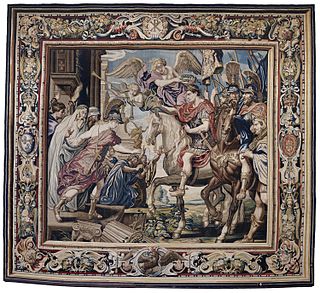 W
WThe History of Constantine is a series of tapestries designed by Flemish artist Peter Paul Rubens and Italian artist Pietro da Cortona depicting the life of Constantine I, the first Christian emperor of Ancient Rome. In 1622, Rubens painted the first twelve oil sketches that were used as guides, and the tapestries themselves were woven in the workshop of Marc Comans and François de la Planche in the Faubourg Saint-Marcel in Paris by 1625, transforming each small sketch into a sumptuous creation of wool, silk, and gold and silver threads that could easily fill a wall. An additional five designs were painted by Cortona in 1630 and woven in the atelier of Cardinal Francesco Barberini in Rome over the next decade.
 W
WThe Hunt of the Unicorn or the Unicorn Tapestries is a series of European tapestries dating from the late Middle Ages. This series of seven tapestries now in The Cloisters in New York was possibly made – or at least designed – in Paris at the turn of the sixteenth century. They are one of the canonical works of Late Middle Ages/Early Renaissance art and show a group of noblemen and hunters in pursuit of a unicorn through an idealised French landscape. The tapestries were woven in wool, metallic threads, and silk. The vibrant colours, still evident today, were produced from dye plants: weld (yellow), madder (red), and woad (blue).
 W
WHunting of Birds with a Hawk and a Bow is a 16th-century tapestry in the collection of the Metropolitan Museum of Art. Woven from dyed wool and silk thread, the tapestry is part of a larger series of hunting tapestries attributed to the Southern Netherlands.
 W
WThe Jagiellonian tapestries, are a collection of tapestries woven in the Netherlands and Flanders, which originally consisted of 365 pieces assembled by the Jagiellons to decorate the interiors of the royal Wawel Castle in Kraków, Poland. The collection is also collectively known as the Wawel Arrasses, as the majority of the preserved fabrics are in the possession of the Wawel Castle Museum and the French city of Arras, which was once a manufacturing centre of this kind of wall decoration in the beginning of the 16th century. The works became state property of the Crown of the Kingdom of Poland according to the will of Sigismund II Augustus.
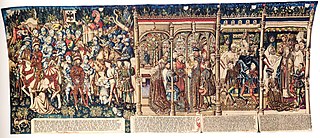 W
WThe Justice of Trajan and Herkinbald was a set of four large panels painted by the Flemish painter Rogier van der Weyden that decorated one wall of a court-room in the Town Hall of Brussels. They represented the Justice of Trajan, a Roman emperor, and the Justice of Herkinbald, a legendary Duke of Brabant. The panels were intended as a reminder to judges to dispense impartial justice and were admired by generations of visitors, including Albrecht Dürer. They were destroyed when the city was bombarded by the French in 1695 and are now known only from descriptions and from a tapestry copy in the Historical Museum of Bern.
 W
WKesi is a technique in Chinese silk tapestry, admired for its lightness and clarity of pattern. It is a tapestry weave, normally using silk on a small scale compared to European wall-hangings. Clothing for the court was one of the main uses. The density of knots is typically very high, with a gown of the best quality perhaps involving as much work as a much larger European tapestry. Initially used for small pieces, often with animal, bird and flower decoration, or dragons for imperial clothing, under the Ming dynasty it was used to copy paintings.
 W
WA kilim is a flat tapestry-woven carpet or rug traditionally produced in countries of the former Persian Empire, including Iran, Azerbaijan, the Balkans and the Turkic countries of Central Asia. Kilims can be purely decorative or can function as prayer rugs. Modern kilims are popular floor coverings in Western households.
 W
WThe Lady and the Unicorn is the modern title given to a series of six tapestries created in the style of mille-fleurs and woven in Flanders from wool and silk, from designs ("cartoons") drawn in Paris around 1500. The set, on display in the Musée de Cluny in Paris, is often considered one of the greatest works of art of the Middle Ages in Europe.
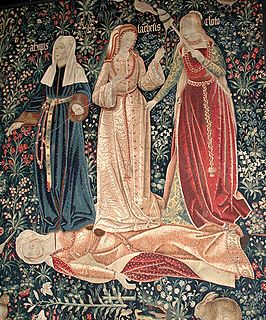 W
WMillefleur, millefleurs or mille-fleur refers to a background style of many different small flowers and plants, usually shown on a green ground, as though growing in grass. It is essentially restricted to European tapestry during the late Middle Ages and early Renaissance, from about 1400 to 1550, but mainly about 1480–1520. The style had a notable revival by Morris & Co. in 19th century England, being used on original tapestry designs, as well as illustrations from his Kelmscott Press publications. The millefleur style differs from many other styles of floral decoration, such as the arabesque, in that many different sorts of individual plants are shown, and there is no regular pattern. The plants fill the field without connecting or significantly overlapping. In that it also differs from the plant and floral decoration of Gothic page borders in illuminated manuscripts.
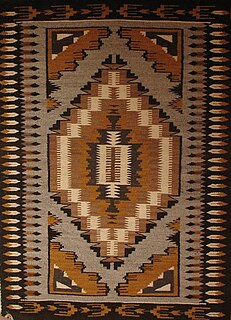 W
WNavajo rugs and blankets are textiles produced by Navajo people of the Four Corners area of the United States. Navajo textiles are highly regarded and have been sought after as trade items for over 150 years. Commercial production of handwoven blankets and rugs has been an important element of the Navajo economy. As one expert expresses it, "Classic Navajo serapes at their finest equal the delicacy and sophistication of any pre-mechanical loom-woven textile in the world."
 W
WThe Oseberg tapestry is a fragmentary tapestry, discovered within the Viking Oseberg ship burial in Norway.
 W
WThe Överhogdal tapestries are a group of extraordinarily well-preserved textiles dating from late Viking Age or early Middle Ages that were discovered in the village of Överhogdal in Härjedalen, Sweden.
 W
WThe Pastoral Amusements, is a series of tapestries designed between 1720 and 1730 by Jean-Baptiste Oudry for Noël-Antoine de Mérou, then director of the Royal Beauvais Tapestry Manufactory. The first production of the designs took place at Beauvais in 1731. After enjoying huge success the series was later adapted and further developed at Aubusson by Jean-Baptiste Huet the elder.
 W
WThe Pastrana Tapestries are four large tapestries commissioned by king Afonso V of Portugal to celebrate the successful conquest of the Moroccan cities of Asilah and Tangier by the Portuguese in 1471. Each measures about 11 by 4 meters, and are made of wool and silk.
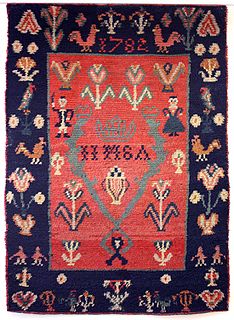 W
WRyijy is a woven Finnish long-tufted tapestry or knotted-pile carpet hanging.
 W
WSt. Hedwig's Cathedral is a Catholic church on Bebelplatz in the historic centre of Berlin. Dedicated to Hedwig of Silesia, it was erected from 1747 to 1887 by order of Frederick the Great according to plans by Georg Wenzeslaus von Knobelsdorff in Baroque style. Damaged during the Allied bombing in World War II, the cathedral of the Archdiocese of Berlin was restored from 1952 to 1963 in post-war modernist style as part of the Forum Fridericianum. Since 2018, the listed building has been closed for renovation.
 W
WThe Sampul tapestry is an ancient woolen wall-hanging found at the Tarim Basin settlement of Sampul in Lop County, Hotan Prefecture, Xinjiang, China, close to ancient city of Khotan. The object has many Hellenistic period features, including a Greek centaur and diadem, linking it to the Greco-Bactrian Kingdom. It may represent a Yuezhi soldier, in red jacket and trousers, from the 1st century CE.
 W
WThe Scottish Royal tapestry collection was a group of tapestry hangings assembled to decorate the palaces of sixteenth-century kings and queens of Scotland.
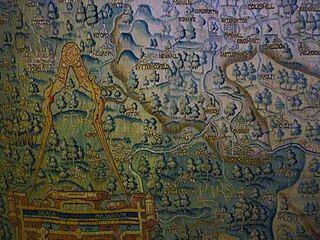 W
WSheldon tapestries were produced at Britain's first large tapestry works in Barcheston, Warwickshire, England, established by the Sheldon family. A group of 121 tapestries dateable to the late 16th century were produced. Much the most famous are four tapestry maps illustrating the counties of Gloucestershire, Worcestershire, Oxfordshire and Warwickshire, with most other tapestries being small furnishing items, such as cushion covers. The tapestries are included in three major collections: the Victoria and Albert Museum, London; the Metropolitan Museum of Art, New York; and the Burrell Collection, Glasgow, Scotland. Pieces were first attributed in the 1920s to looms at Barcheston, Warwickshire by a Worcestershire antiquary, John Humphreys, without clear criteria; on a different, but still uncertain basis, others were so classified a few years later. No documentary evidence was then, or is now, associated with any tapestry, so no origin for any piece is definitely established.
 W
WThe Raphael Cartoons are seven large cartoons for tapestries, belonging to the British Royal Collection but since 1865 on loan to the Victoria and Albert Museum in London, designed by the High Renaissance painter Raphael in 1515–16 and showing scenes from the Gospels and Acts of the Apostles. They are the only surviving members of a set of ten cartoons commissioned by Pope Leo X for the Sistine Chapel tapestries for the Sistine Chapel in the Vatican Palace, which are still hung below Michelangelo's famous ceiling.
 W
WThe Skog tapestry is a medieval textile work of art which was discovered in Skog Church in Sweden in 1912. Its subject matter remains a matter of discussion. The tapestry is presently housed in the Swedish History Museum in Stockholm.
 W
WThe Story of Caesar and Cleopatra is an amalgamation of fourteen tapestries put together by the Art Institute of Chicago from three separate tapestry series in their collection. The original tapestry series' were the Story of Caesar Augustus, the Story of Cleopatra, sometimes referred to as the Story of Cleopatra and Antony, and the Story of Zenobia and Aurelian, all designed by Justus van Egmont in the 17th century. The tapestries were made in the Flemish High Baroque style. They were produced by some of the leading weaving workshops of the time and were commercially successful.
 W
WThe Triumph of Fame is a tapestry made in Flanders in the 1500s. It is in the collection of the Metropolitan Museum of Art.
 W
WThe Valois Tapestries are a series of eight large tapestries depicting festivities or "magnificences" held by Catherine de' Medici's Royal Courts in the second half of the 16th century. The tapestries were primarily modeled on drawings by Antoine Caron, but to Caron's distant views of large panoramas crowded with figures much larger portraits of leading persons at the French court have been added in the foreground, usually to the side, as well as elaborate borders.